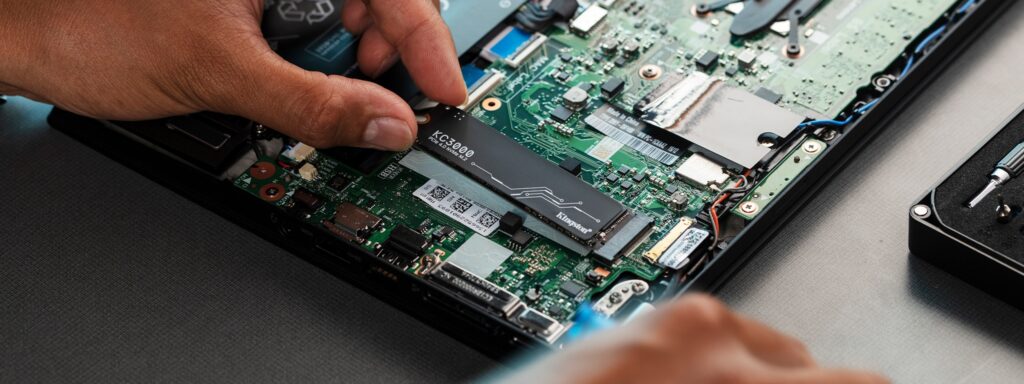In modern computing, performance is everything. Whether you are loading massive open-world games, editing 4K footage, or managing heavy workloads, storage speed can make or break your experience. The shift from SATA drives to PCI Express (PCIe) SSDs has been one of the biggest upgrades in recent years. These drives deliver the kind of speed, efficiency, and reliability that both gamers and professionals demand.
PCIe SSDs use the NVMe protocol over the PCI Express interface, allowing direct communication with the CPU. This design eliminates old data bottlenecks and provides exceptional read and write speeds, faster load times, and improved multitasking. Simply put, PCIe SSDs have become the standard for performance-driven systems.
Why PCIe SSDs Matter
A PCIe SSD connects directly to the processor through high-speed PCI Express lanes. This allows much higher bandwidth and lower latency compared to SATA drives.
Key Advantages:
- High throughput with read speeds up to 14,000 MB/s on PCIe 5.0 models
- Lower latency and faster responsiveness in real-world tasks
- Efficient parallel command handling through the NVMe protocol
- Better scalability for gaming, content creation, and enterprise applications
For gamers, this means lightning-fast game loading and zero stutter when streaming assets. For professionals, it results in faster renders, quicker file transfers, and reduced downtime during large data operations.
Understanding PCIe Generations
Each generation of PCI Express technology doubles the bandwidth of the previous one. Backward compatibility allows newer drives to work in older systems, but performance depends on the interface supported by your motherboard and CPU.
| Generation | Max Bandwidth (x4) | Typical Use |
|---|---|---|
| PCIe 3.0 | Up to 3,500 MB/s | Entry-level or older systems |
| PCIe 4.0 | Up to 7,000 MB/s | Mainstream gaming and workstations |
| PCIe 5.0 | Up to 14,000 MB/s | High-end PCs and heavy workloads |
For most users in 2025, PCIe 4.0 SSDs offer the best balance between speed, heat management, and cost. PCIe 5.0 is ideal for enthusiasts or professionals pushing extreme workloads.
Top PCIe SSDs in 2025
Below are some of the best PCIe SSDs available today, selected for performance, reliability, and overall value.
1. Samsung 990 PRO (PCIe 4.0 NVMe)
The Samsung 990 PRO remains the gold standard for performance and consistency. It delivers up to 7,450 MB/s read and 6,900 MB/s write speeds, making it perfect for demanding gaming and creative applications.
Specifications:
- Capacities: 1TB to 4TB
- Controller: Samsung Pascal
- Endurance: Up to 2,400 TBW
- Thermal Control: Dynamic Thermal Guard
Its sustained performance and excellent reliability make it a favorite among professionals and gamers alike.
2. WD Black SN850X (PCIe 4.0 NVMe)
The WD Black SN850X combines top-tier performance with gaming-focused firmware optimization. It supports read speeds up to 7,300 MB/s and write speeds up to 6,600 MB/s.
Highlights:
- Capacities: 1TB to 4TB
- Features: Game Mode 2.0 for low-latency gaming
- Optional heatsink version with RGB lighting
- PS5 compatible
This drive is an excellent choice for gamers seeking consistent speed and reliability across both console and PC platforms.
3. Crucial T700 (PCIe 5.0 NVMe)
The Crucial T700 represents the cutting edge of PCIe 5.0 technology, with sequential read speeds of up to 12,400 MB/s. It delivers exceptional performance for professional-grade workloads and next-generation gaming systems.
Key Details:
- Interface: PCIe 5.0 x4
- Capacities: 1TB to 4TB
- Cooling: Active heatsink recommended
- Ideal for: AI workloads, 3D rendering, and high-end desktops
If you are building a system on platforms like AMD X670E or Intel Z790, the T700 is the ultimate choice for raw performance.
4. Sabrent Rocket 4 Plus (PCIe 4.0 NVMe)
The Sabrent Rocket 4 Plus provides impressive speeds at a competitive price. It is known for consistent sustained performance and strong endurance ratings.
Specifications:
- Read/Write: 7,000 / 6,850 MB/s
- Capacities: Up to 8TB
- Controller: Phison E18
- Optional copper heat spreader for better thermals
This SSD is ideal for creators, developers, or users handling large video and data files.
5. Kingston KC3000 (PCIe 4.0 NVMe)
The Kingston KC3000 delivers balanced performance for both gamers and professionals. It uses premium TLC NAND with a Phison E18 controller to maintain steady throughput under load.
Specifications:
- Speeds: Up to 7,000 MB/s (read/write)
- Endurance: Up to 1,600 TBW
- Low-profile graphene aluminum heat spreader
It offers great stability and is a strong choice for compact or thermally constrained builds.
What to Consider When Choosing a PCIe SSD
1. Interface Support
Check your motherboard’s PCIe generation support. Installing a PCIe 5.0 SSD on a PCIe 3.0 slot will limit performance to the older bandwidth.
2. Thermal Management
High-speed SSDs can run hot during continuous use. Choose models with built-in heatsinks or ensure good airflow to prevent throttling.
3. Endurance Rating (TBW)
Look for Total Bytes Written (TBW) values above 1,000 TBW for heavy workloads like video editing or compiling large codebases.
4. Capacity
For modern gaming and productivity, 1TB is the minimum recommended size. Professionals should consider 2TB or more for efficiency.
5. NAND and Controller Quality
TLC NAND with high-quality controllers provides more consistent long-term performance compared to QLC-based budget models.
PCIe SSDs vs SATA SSDs
| Feature | PCIe NVMe SSD | SATA SSD |
|---|---|---|
| Interface | PCI Express | SATA III |
| Max Speeds | Up to 14,000 MB/s | Up to 550 MB/s |
| Latency | Under 100 µs | Around 400 µs |
| Ideal Use | Gaming, editing, high-performance systems | Everyday computing |
Even a mid-range PCIe SSD dramatically outperforms the fastest SATA drives, offering instant boot times and near-zero load delays.
The Future of PCIe Storage
PCIe 5.0 drives are setting new standards for speed, and PCIe 6.0 is already on the horizon. The next generation of SSDs will bring even higher bandwidth, improved power efficiency, and smarter controllers capable of predictive caching and workload optimization.
For most users, PCIe 4.0 remains the best choice for balanced performance and thermal control. However, enthusiasts and professionals who rely on top-tier speed will find PCIe 5.0 an excellent investment for future-ready builds.
Final Thoughts
Upgrading to a PCIe SSD is one of the most effective ways to enhance overall system responsiveness. Whether you choose the Samsung 990 PRO for unmatched reliability, the Crucial T700 for cutting-edge PCIe 5.0 performance, or the Sabrent Rocket 4 Plus for exceptional value, every option here represents a major step up from traditional SATA storage.
For gamers and power users alike, PCIe SSDs have become more than just fast storage they are the backbone of a truly modern computing experience.



